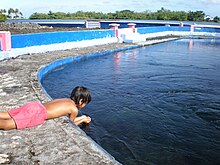Sina and the eel
Sina and the Eel ( Samoan : Sina ma le Tuna , English: Sina and the Eel ) is a founding myth in the mythology of Samoa . The story explains the origin of the first coconut palm .
Tuna is the Samoan word for eel , while Sina occurs as a name for various female characters in Polynesian mythology. In the Samoan language , the word can also mean “white” or silver -haired (old-age gray-haired). An ancient Samoan song, Soufuna Sina , is based on the legend.
The story has spread widely and is also known in Tonga , Fiji, and the Māori in New Zealand .
Accordingly, there are different versions of the legend.
background
The coconut palm ( Cocos nucifera ) is used in a variety of ways and provides important staple foods. In addition, coconut oil , wickerwork such as baskets, sennit cords are made for traditional house building, for weaving and for making smaller fals . The dried coconut meat, copra , is also an important export product and therefore a source of income in Oceania .
The legend of Sina and the eel is linked to other figures in Polynesian mythology such as Hina , Tinilau , Tagaloa and Nafanua .

Legend
On the island of Savai'i in Samoa lived a beautiful girl named Sina, whose beauty was known throughout the Pacific. The Tui Fiti (King of Fiji), who was much older than Sina, heard about it. He gathered his courage and decided that he wanted to see it for himself. Using his mana (magic), he turned himself into an eel and went to the village where Sina lived. When he settled in the village pool, he immediately discovered how beautiful Sina was. However, when Sina looked into the pool, all she saw was the eel staring at her.
Full of anger, she shouted: "You are staring at me with eyes like a demon" ( Samoan E pupula mai, ou mata o le alelo! ). But soon Sina realized that the eel was nice and made it her cuddly toy. Years passed and the Tui Fiti grew old and weak, and with it its magic. He decided to reveal himself and explained to Sina that he had once been the King of Fiji and had come here to see her beauty and that he knew that he would have no chance with her because of his age. He asked Sina to plant his head in the ground. Sina complied with his request and planted the head of the eel. A coconut palm grew out of it. When the fiber covering of a coconut is removed, you can see three round scars that look like the face of a fish with two eyes and one mouth. One of the scars is pierced to drink the coconut, and when Sina drinks like this it is like kissing the eel.
In Samoa, the Mata o le Alelo freshwater pool in the village of Matavai, Safune , is identified with this legend. The pool is named after Sina's words for the eel.
variants
A variation on the story says that Sina came from the village of Laloata on Upolu . Her father is named there as Pai .
On Mangaia in the Cook Islands there is a variant of the legend in which the beauty is called 'Ina-moe-Aitu ("Ina with the divine lover"). There she lived in a cave near Tamarua and bathed in a stream in her cave.
Popular culture
The song “You're Welcome” from the Walt Disney Pictures film Vaiana (Moana) from 2016 refers to Sina and the eel . In it, however, it was the demigod Māui who killed the eel and buried its entrails to grow coconut palms. While he sings the song for Moana, Maui is playing with a coconut. Even if it is not pronounced in the film, Moana's mother is referred to as "Sina". In her song “Where You Are” Sina is shown showing Moana the coconut harvest and the uses of the different parts of the coconut tree.
Individual evidence
- ↑ Living Heritage .
- ↑ O le Tala ia Sina ma lana Tuna (Sina and the Eel)
- ↑ George Pratt: A Samoan Dictionary English and Samoan, and Samoan and English; with a Short Grammar of the Samoan Dialect . London Missionary Society's Press, 1862, p. 23.
- ↑ Robert D. Craig: Handbook of Polynesian Mythology . ABC-CLIO, 2004, ISBN 978-1-57607-894-5 , p. 88.
- ↑ Kate McCosh Clark: Maori Tales and Legends . Read Books, 2008, ISBN 978-1-4437-5874-1 , p. 68.
- ↑ Jeannette Marie Mageo: Cultural Memory Reconfiguring History and Identity in the Postcolonial Pacific . University of Hawaii Press, 2001, ISBN 978-0-8248-2386-3 , p. 72.
- ↑ George Turner: Samoa a Hundred Years Ago and Long Before . BiblioBazaar, 2007, ISBN 978-1-4346-2473-4 , p. 185.
- ↑ 'Ina and Tuna .


